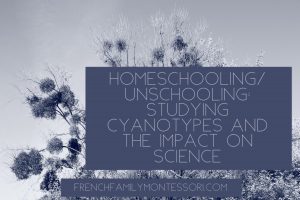
I read this book with the girls for the first time last night. Not only did I instantly fall in love with it, I knew the lessons it would inspire. I mean, Anna Atkins combined art and science for her book, so just envision the studies that will go along with it!
I’ve been asked to put more unschooling/homeschooling topics together and this is something I truly enjoy doing. Not only does this give my mum ideas to do with T (she is still able to see him during the pandemic), but they are things I plan on doing with the girls more and more. I slightly modify for them to enjoy now, but they will enjoy more in-depth in time.
Won’t lie, when I first came across this book at the library (we’ve since purchased it) I thought it would be fun, but not very Montessori. But, there’s a reason it’s illustrated the way it is. Upon reading the book, it makes complete, wonderful sense–I don’t want to ruin anything about it, so I won’t go more in depth.
Here are a few activities that it has inspired:
Collecting specimens: This is something the girls have been enjoying for awhile now. We take their little bucket and they collect fallen leaves and plants. Decide what you want your journal to be about and collect the specimen needed–please be mindful to respect living things and do no harm, this is why we collect fallen plant leaves and such.
Create a journal: Like Anna, find the scientific names of your specimen and illustrate them. Don’t forget to use a microscope, magnifying glasses and drawn up close illustrations, as well.
Create cyanotypes aka sun prints: We use these, being 5×7 they are the perfect size for our journal and we get many for the price, allowing for plenty practice. Or, create your own with the chemicals.
Study: Anna Atkins, John George Children, Sir John Herschel, the Royal Society of London, Royal Entomology Society, calotype, William Henry Fox Talbot, Constance Fox Talbot, cyanotype and the chemicals used to create it: potassium ferricyanide and ferric ammonium citrate and, perhaps, create your own. Check out the different chemicals that can intensify or alter the colours, like lemon juice and oolong tea. Research the works of current artists still using cyanotype, like Kate Cordsen and John Dugdale. Learn about other women in science, the suffragette movement and the impact that was had (here, here, here, and here and a few interesting reads on those topics).
Have you created sun prints before?
This post contains affiliate links at no extra cost to you.
.
.
.

